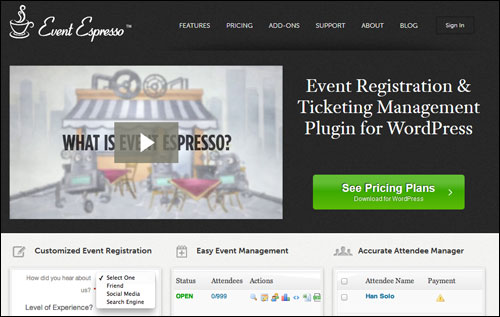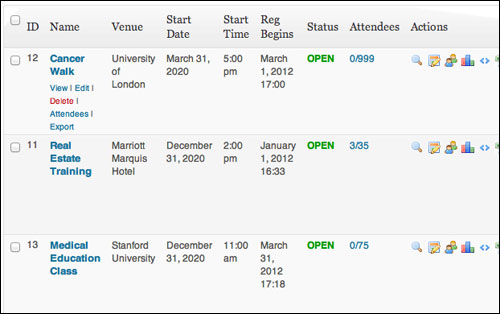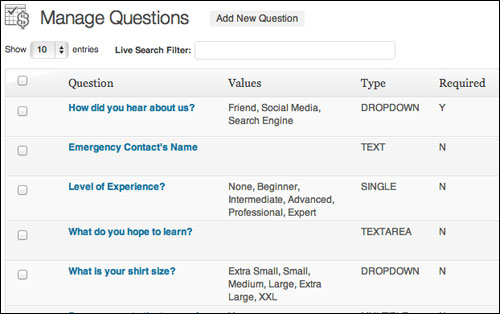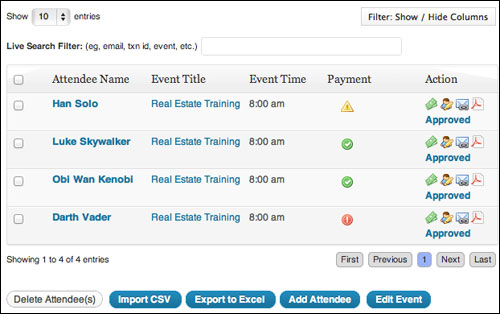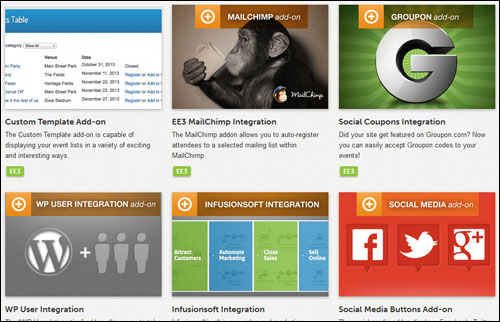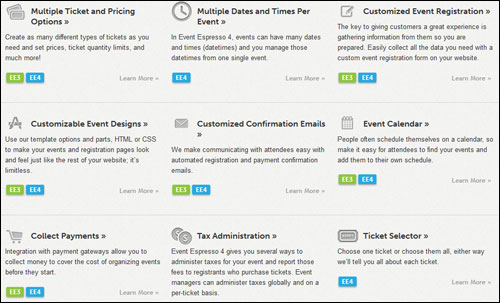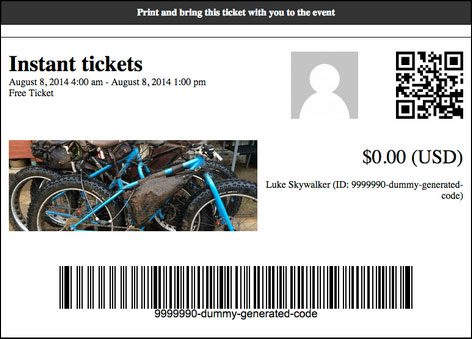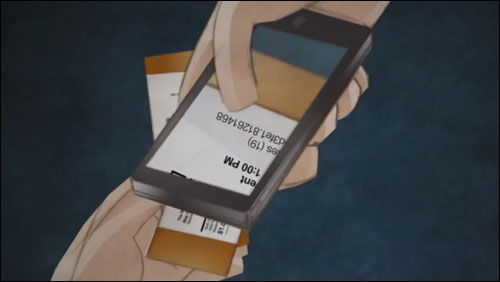 Do you currently run or plan to run events that need to accept registrations, such as workshops, group classes, non-profit fund raisers, social conferences, or even a big event such as an exhibition, a sporting or religious event, or any kind of event where people need to register to attend?
Do you currently run or plan to run events that need to accept registrations, such as workshops, group classes, non-profit fund raisers, social conferences, or even a big event such as an exhibition, a sporting or religious event, or any kind of event where people need to register to attend?
Co-ordinating event bookings can be a time-consuming process. You need to manage scheduling, event dates, registration numbers, data collection, collecting payments and sending invoices, confirmations and reservations, reminders, cancellations … perhaps even accommodating special needs and providing tickets to participants.
There are a number of advantages to setting up a web-based event registration system. It can streamline your business processes, save time and reduce costs, help you easily reproduce previous events, give event managers more control, create a better customer experience and grow your sales.
The problem is that setting up an online event registration system can be costly.
Fortunately, if you run a WordPress-powered digital presence, you can install a very inexpensive and professional online event registration system.
Announcing …
Event Espresso – Event Management And Ticketing Registration Software For WordPress
Plugin Description
The Event Espresso online event registration plugin lets you easily set up multiple events and start accepting bookings in just a few minutes.
(Set up multiple events and accept online event registrations with Event Espresso)
Event Espresso is a flexible and feature-packed software that gives you complete control of the event registration management process.
Customize registration forms
You can employ a range of event registration strategies, from simple online enrolments and straight up ticket sales, to creating custom registration forms for collecting detailed information about your attendees, or integrating your event bookings with social media sites like Facebook.
Access detailed information about your event attendees
Note: At the time of writing this article, Event Espresso offers two different versions of their plugin: Event Espresso 3 and EE 4. The new Event Espresso 4 is impressively different than the older EE 3, as the software is being revamped using a different structure to allow for future expansion. The EE 4 plugin software has different features, user interface, data structure, coding method and price. The company plans to eventually transition completely to EE 4, so keep this in mind as you read more about the benefits and advantages of this plugin.
Learn more about the plugin here:
Benefits Of Using Event Espresso
Here are just some of the benefits of using Event Espresso to manage event registrations on your website:
Automated Event Registration Management And Ticketing Solution
Event Espresso provides you with everything you need to turn your current web site into a fully-featured and automated event management website … from custom registration forms and automated response emails, to maximum seating limits, multiple pricing levels and discount codes, to printable tickets and seating charts.
Increased Business Productivity
By using a web-based event registration system like Event Espresso, you save time and increase your business productivity by virtually eliminating the need to process registrations and bookings manually.
Basically, you are enabling event attendees to register themselves.
Allowing your enrollees to do all of the data themselves frees you up from doing admin work and lets you concentrate more of your attention on organizing a memorable event.
More Control Over The User Experience
As you will learn shortly, Event Espresso gives you complete control over the event management and booking process that you want your participants to experience.
Additional plugin benefits include:
- Reduced Costs: The Event Espresso plugin gives you a very inexpensive online event registration management solution compared to building your own software or using a 3rd party provider. This is made possible by using a model where you start with the core plugin (which suits the requirements of most users) and then buy optional addons only when you need extra features.
- Higher Sales: Event Espresso lets you accept online event registrations 24/7. In addition, Event Espresso social and marketing add-ons (see below) let people who are interested in registering for your event share your information with friends who may also be interested in attending.
- Paperless Event Sign-Up Process: With Event Espresso, the event sign-up process remains wholly online, significantly reducing traditional paper waste from tasks related to enrollment.
- All Information Belongs To You. You control all the data you collect from your event participants.
Event Espresso Features
The Event Espresso software delivers functionality to its users via standard features (these are included with the software) and optional features that customers can purchase, called add-ons.
Event Espresso provides many built-in to WordPress users. Here are just a few:
- Fast and easy to install and use. Be up and running in minutes.
- Multiple Dates and Times Per Event. In EE 4, events can have many dates and times (datetimes), which these can be managed from a single event.
- Event Calendar. Registrants can easily find your upcoming events and add these to their schedule with the WordPress calendar.
- Collect Payments. Event Espresso integrates with leading payment gateways, enabling you to collect booking fees before running your events.
- Custom Post Types. You can Event Espresso into your WP theme and reuse contact information throughout other areas of your site.
- Default Price Types. Price types allow you to create new prices that adjust the default ticket price of the default ticket.
- Mobile Registration & Ticketing Apps. The Event Espresso mobile registration system allows you to authenticate tickets, speed up in-venue registrations, create multiple check-in “stations” and track your participants.
- Contact Profiles And Contact List. EE 4 lets you gain a better understanding of who your customers are and how you have done past business with your clients. The Contact Profile section stores updated records like the name, biography, contact details, event registration information, private comments, etc. about each customer.
- Waiting Lists. Interested persons can subscribe to a waiting list if your event has reached maximum attendance. You can also specify that wait-listed members pay for their spots if you plan to expand capacity for your event.
- Public Commenting. Add “social proof” by allowing potential registrants to ask questions about your event and past attendees to post reviews that can help others choose whether or not to register. Moderation settings for public commenting are configured via the WordPress built-in commenting admin area.
- Search Engine Friendly URLs. Keyword-rich URLs take advantage of your WordPress site’s Permalinks configuration settings. “Pretty” permalinks that have relevant keywords enhance the context of your pages and improves your search rankings, helping you get more potential customers to your site.
- Country-specific Settings. Event managers can configure the country and currency settings that will be used throughout Event Espresso, such as currency name, currency signs, decimal characters and places, country codes, states or provinces, etc.
- Default Tickets. If you find yourself creating identical tickets for your events, you can set one of those tickets as your default ticket for any new events simply by ticking a checkbox.
- WYSIWYG Editor. Event Espresso uses the built-in WordPress WYSIWYG editor, so you can quickly and easily add images and compose and edit your content without having to know HTML or CSS, just like any WP post or page.
- Event Espresso Community. Event Espresso lets you interact with an expert community of experienced event managers and other plugin users. You can engage with other Event Espresso users using their community chat room, support forums, job board, and social media discussions on Twitter, Facebook, Linkedin and Google+.
- Invoice Payment Reminders. Follow-up potential registrants who have not fully paid for their admission with a standard but personalized PDF invoice with just one click. Your invoices will reference pre-registered attendees who have not paid their registration yet by name, give them the amount owing, and include links to the event information, a payment link and a url where they can download the invoice.
- Attendee Reporting. Event reporting provides you with data of all of your registrations and transactions, allowing you to measure the performance of your events with the aggregate number of registrations and how much money you have collected.
Extra features include:
- Object-Oriented Programming (OOP). Event Espresso is simple enough for basic users, and also robust and customizable for higher end users and developers. The bottom line is that by using OOP, Event Espresso 4 allows for more complex enhancements and customizations to the application.
- Maintenance Mode. You can pause registrations for normal site visitors when you need to make updates on your site. You can still work on your content during maintenance mode.
- Flexibility, Autonomy & Value For Money: According to the mission statement on their website, Event Espresso’s aim is to “empower business and organization leaders with the event registration, ticketing and management tools that maximize the success of events.” To achieve their mission, the software has been built using a modular and highly efficient model that provides users with great autonomy and flexibility and delivers value for money in the process.
The premium version of Event Espresso also comes with 40+ added features, including:
- Email shortcodes that includes registrant data in emails and updates.
- Default surcharge (similar to adding a service fee to all tickets).
- Category titles and descriptions on event listing pages.
Event Espresso Add-Ons
As well as an incredible number of features, Event Espresso provides “addons”, which allow software users to further enhance the capabilities of your event management process.
Some of these add ons include:
- EE4 Events Grid Template Add on: Displays events in a pure CSS grid-like structure using the featured image. Hovering over the image will display further information. If an event does not have a featured image, it will use a default image.
- Recurring Events Management Addon: The Recurring Events management add on enables you to put events on autopilot by scheduling recurring events weeks or months in advance. You can add as many future events as you need. Event Espresso will automatically open and close registrations for all of your recurring events.
- Events Category Accordion Template Addon: The Category Accordion template displays categories as a simple list. Clicking a category name shows all events associated with that category and closes any previously open categories.
- Social Media Buttons Add-on: The social media addon displays Facebook, Twitter and Google+ buttons in your events. The Social Media add on is included free with all of the Event Espresso support licenses.
- Custom Files Addon: The Custom Files add on allows you to override certain aspects of the Event Espresso plugin.
- Roles And Permissions Basic And Pro Add-on Versions: This addon lets you include your staff in your organization to help manage your events and give new users permission to create events or regional managers permission to manage events. The Roles and Permissions Basic add-on allows you to manage & customize the WP users roles and give them different permissions with different privileges, so your staff can help you manage your events or the events that other people create. You can customize roles so that users do not have access to certain sections of your WordPress dashboard and/or certain parts of your Event Espresso settings. If you’d like to create geographic regions for other people to manage events, use the Roles and Permissions Pro add on.
- Multiple Event Registration Add on: The Multiple Event registration add-on gives potential customers the ability to book multiple events at once. In each event listing attendees will be given the option to either register for a single event or add multiple events to their cart. With the Multi-Event Registration add-on, attendees can register for several events at once and even add additional attendees to any of the same events in the same checkout process.
- EE4 Events Table View Template Add on: The Events Table Template add-on provides you with a simple and easy-to-use system that allows you to change the design of your event lists. It comes with a simple table template with category filters, table search, table paging and more. It also allows developers to design their own custom templates using one of the templates included as a source template.
- EE4 Infusionsoft Integration Addon: With the Event Espresso 4 Infusionsoft integration all-in-one sales and marketing plugin add on, you can completely automate your customer relations and email marketing campaigns to seamlessly capture customer data, track bookings, and accept payments from your website.
Note: The Event Espresso development team is continually adding new features and improvements to the plugin, including new addons.
For more details about the latest Event Espreso features and addons, visit the plugin website here:
Testimonials
Below are just some of the many testimonials that satisfied customers have posted about Event Espresso:
”Broadcasting my support for Event Espresso will be a pleasure. I recently helped the Webmaster at a sister church configure your event manager for their site, so I can say with confidence and from experience, that Event Espresso is the best Event Manager plugin ever!” Philip Simpson, The Charlotte Church
”I have to say that it has been the right choice for me…I’ve been extremely pleased with the way my site is working.” Robin, RobinTime
”You guys have done an AWESOME job with this system…promise me to keep up the excellent work you guys are doing, for as long as you can… Respect!” Robert Jarnroth, Jarnroth Digital Productions
Useful Tips
Whether you are a motivational speaker, trainer, seminar promoter, or event consultant, there are simply countless possibilities of what you can achieve with the Event Espresso software.
After purchasing the plugin and becoming a licensed user, go through the support forum for inspiration and practical ways to improve your event management process and improve the experience of your customers.
Event Espresso Support
Event Espresso works with with all WordPress plugins and themes that follow WordPress coding standards. If you do need help with the plugin, however, you will find that Event Espresso provides highly responsive customer support, as many of its satisfied users confirm:
”These guys are right on any problem or issue or even general questions. You can’t really put a value high enough on the kind of support these guys offer.” Mark Wigston, Muskoka Graphics
Event Espresso provides great support including access to a support forum, comprehensive online documentation with faqs, knowledge base and how tos, one-on-one support and even a monthly VIP member pass giving you access to community of developers, designers, event managers, publishers and webmasters that use Event Espresso tools, plus faster support response times.
In addition, Event Espresso boasts a well-staffed team of experienced web developers with a proven track record of support, so this is definitely software you can rely on to run your events.
Software Pricing
Event Espresso is available in various editions, including a FREE basic edition (named Event Espresso Decaf). For personal support and advanced software features, however, you should consider downloading one of the paid plugin versions below:
- Personal Licensing – This option enables you to run Event Espresso on one site only. Pricing includes 51+ Premium features, (addons sold separately) and 1 year of upgrades and support. Cost = $69.95.
- Everything Licensing – This enables you to set up Event Espresso on 1 domain only. Includes 51+ Premium features, 29 Premium add-ons and 1 year of upgrades and support. Cost = $279.95.
- Developer Licensing – This license lets you set up Event Espresso on five domains. It includes 51+ Premium features, (add ons sold separately) and one year of upgrades and support. Cost = $249.95.
The cost to purchase the Event Espresso plugin depends on whether there are any promotions or limited-time special offers. Presently, the plugin is selling for the prices shown above. Check the plugin’s website for the current pricing: Event Espresso – Event Management & Ticket Registration Plugin For WordPress
Please Note: The pricing above was current at the time this review was written. This may or may not be the actual price charged by the plugin author when you visit the site.
Event Espresso – Additional Plugin Information
Event Espresso regularly adds new features and improvements to its plugin. Make sure to stay subscribed to their customer update list to receive the latest information and updates.
Look up the plugin’s documentation tools to find answers to common questions about setting up and how to use Event Espresso, and visit the support forums for questions related to a specific use-case, or to notify developers about errors and leave feedback.
For all documentation, demos, downloads, videos, tutorials, FAQ and more, visit the Event Espresso web site.
The Bottom Line
Event Espresso is the preferred WordPress event registration and ticketing management software, used by thousands of WP site owners.
If you are a WordPress site owner and you currently run events that require scheduling dates and venues (offline and online), enrolling attendees, and booking tickets or seating, then you will probably not find a better software for your needs than Event Espresso.
For full details, check out the plugin here: Event Espresso – WordPress Event Registration & Ticketing Management Software
***
